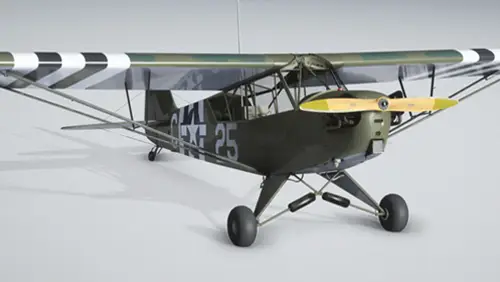- USD 16.99
- -26%
- USD 16.99
- USD 12.49
- Sale Ends: July 10 2025 5:00 PM +00:00
- View more offers at FS Addon Compare
- Added: July 28, 2022
- Updated: January 12, 2023
This package contains three individual models:
- Air Observation Post, artillery spotter
- General Liaison
- Floatplane
History:
The history of the L-4 is best summed up by Ken Wakefield, author of "The Fighting Grasshoppers" and "Lightplanes at War":
"The Piper L-4 Grasshopper of WW2 was the military version of the highly popular pre-war J3 Cub, by which name it was more widely known to service personnel. Of the 5,500 L-4 variants produced between 1942 and 1945, some went to liaison squadrons and the USAAF, but the vast majority went to US Army Ground Forces, for use as Air Observation Posts (Air OPs) with the Field Artillery. In both air and ground forces, the L-4 was used as a flying Jeep, among other things carrying priority mail and personnel between HQs and command posts. Its Continental engine produced only 65hp, yet the L-4's excelent short field performance enabled it to operate from the smallest of improvised airstrips, including roads, adjacent to command posts.
Unlike most other combat aircraft, the L-4 was unarmed and unarmoured. It was one of the smallest aircraft of WW2 and with a cruising speed of only 75 mph, it was the slowest. Nevertheless, it has been claimed that a single L-4, directing the fire power of an entire Division, could bring a greater weight of explosives to bear on a target than any other aircraft of the period. With the exception of the atomic bomb-carrying B-29 Superfortress, no other aircraft had the destructive capability of the diminutive L-4.
It was most widely used in Europe, where more than 2,700 served with the Field Artillery, and of these nearly 900 were lost through enemy action or in accidents. Of those that survived the war, about 150 were shipped back to the US, most of the remainder eventually being sold to civilian purchasers in Britain, France, Switzerland, Denmark and elsewhere in Europe. More than 60 years on many of these are still flying with, and in recent years an increasing number being restored to, their original military configurations and markings. A truly remarkable 'warbird', long to be remembered."
So successful was the L-4 that its miltary use continued on through the Korean War and Vietnam. Today, hundreds still fly on as civilian light aircraft, some as meticulously restored military aircraft and others in colourful civilian schemes.
Features:
Eight Paint Schemes: WWII:
- 30th Infantry Division
- 2nd Armoured Division
- 2nd Infantry Division (D-Day)
- Floatplanes (2 schemes)
- No.4 Squadron, Royal Australian Air Force (Pacific Campaign)
- French Air Force liaison
Post War (Pacific)
- Royal Netherlands Indies Air Force (1948)
Known issue: Floatplane version performance on water unrealistic, believed due to light weight of aircraft.













